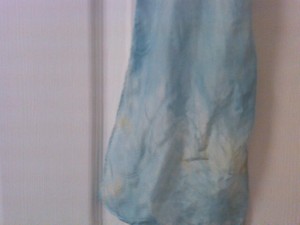If Madder is Queen, then Indigo must be King of natural dyes. Indigo bearing plants occur in many parts of the world. Woad, the blue stuff used by Mel Gibson is actually a form of indigo.
Indigo, unlike onion skins or madder or even cochineal, does not require a mordant. The real problem is preparing the dye to make it useable. Indigo is not water soluble so the water has to be sufficiently alkaline to ‘fix’ the dye onto the fiber.
The real work comes in the processing of the indigo plant into dye. The weed was covered with lime water and soaked. Fermentation began in the vat, resulting in a blue froth rising to the top of the water. The water is drained into a second vat and agitated. Then lime water is added to reduce the dye. Clear liquid rises to the top and sediment containing the dye settles to the bottom.
Excess water is drained and the indigo is dried. It is cut into bricks and left to dry.
I confess I don’t do this. I buy partially reduced indigo dyes, which looks like chunks of blue stone.
These chunks are heated. I add a reducer; thiox dioxide, plus soda ash. Soda ash is like the lime; it makes the water alkaline. The solution is heated and amazingly enough, the liquid turns a funny yellowish green.
Cloth or fiber dipped into the dye comes out that same yellow green but as it hits the air, it turns blue.
This is a really smelly process. One of my students likened it to having a perm. And the smell lingers long after the vat of dye has been removed elsewhere.
Indigo overdyes beautifully and I dyed the above scarf with both the indigo and the madder. The central section is a very interesting mix of blue and peach.

